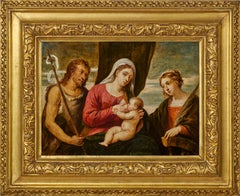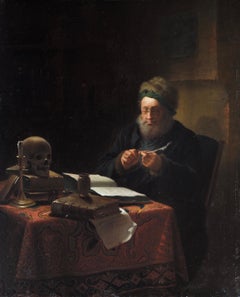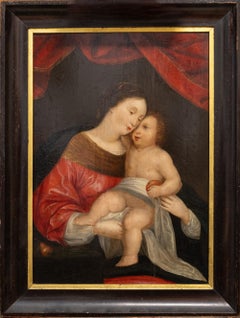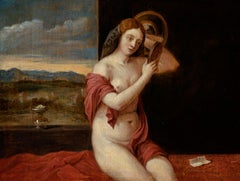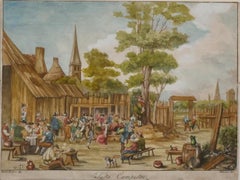David Teniers the Younger Art
Flemish, 1610-1690
David Teniers the Younger was a 17th-century Flemish painter known for his luminous depictions of peasant life. His work was greatly influenced by the tavern scenes of Adriaen Brouwer and the fluid paint handling of Peter Paul Rubens. Born on December 15, 1610 in Antwerp, Belgium, he was the son of the artist David Teniers the Elder, with whom he studied as a youth. Notably, Teniers later married the daughter of the painter Jan Brueghel the Elder. In the early 1630s, the Haarlem-based painter Brouwer moved to Antwerp, Teniers exposure to his low-genre paintings was a turning point in his career. Over the following decades, he enjoyed a popular reputation around Europe. Though most of his works were modest in scale, he was a prolific artist and is thought to have completed some 2,000 paintings over the course of his career. Teniers died on April 25, 1690 in Brussels, Belgium. Today, his work can be found in the Louvre in Paris, the National Gallery of Art in London, the Hermitage Museum in St. Petersburg, and the Rijksmuseum in Amsterdam, among others.to
1
Overall Width
to
Overall Height
to
1
1
1
1
1
1
1
1
1
1
1
1
3
7,820
5,167
2,504
1,501
1
1
Artist: David Teniers the Younger
Virgin and Child, a paiting by David Teniers the Younger after Palma Vecchio
By David Teniers the Younger
Located in PARIS, FR
Provenance:
Dukes of Marlborough Collection, Blenheim Palace until its sale at Christie's London on 26 July 1886 (lot 172)
English private collection until its sale at Christie's London on 11 December 1992 (lot 363)
Erna Weidinger Collection (1923 - 2021) - Austria
Literature :
Georg Scharf - A list of the pictures in Blenheim Palace - Catalogue raisonné Part 2 - London 1862 (page 166 - number 199 "after Palma Giovane")
Charles Davies...
Category
1750s Old Masters David Teniers the Younger Art
Materials
Oak, Oil
Related Items
Scholar Sharpening His Quill Penn Attributed to Justus Juncker, Oil on Panel
Located in Stockholm, SE
Justus Juncker (1703-1763, Germany) Attributed to
Scholar Sharpening His Quill Penn
Expertise: We would like to thank Dr. Fred G Meijer for his valuab...
Category
Early 18th Century Old Masters David Teniers the Younger Art
Materials
Oak, Oil, Panel
17th century Flemish school, Madonna with child and red Drapery. Oil/wood
Located in Firenze, IT
Madonna with Child and Red Drapery, Flemish School, Oil on Oak Panel, 17th Century
Flemish School, 17th century
Technique: oil on oak panel with 4 crossbars
Dimensions: Height: 43...
Category
17th Century Old Masters David Teniers the Younger Art
Materials
Wood, Oil, Wood Panel, Board
Early 19th Century Norwich School oil painting of figures by a river
Located in Harkstead, GB
An incredibly atmospheric oil painting of two figures sitting chatting by a woodland stream . A rare work by this master of early 19th century English painting. A very handsome piece...
Category
Early 19th Century Old Masters David Teniers the Younger Art
Materials
Oak, Oil, Panel, Wood Panel
H 14 in W 11.75 in D 2 in
Rebecca at the Well
Located in New York, NY
Provenance:
Dr. James Henry Lancashire, Manchester-by-the-Sea, Massachusetts, by 1925; probably by descent to:
Private Collection, Cumberland Foreside, Maine, until 2018
This unpublished panel is a characteristic work of the Master of the Apollo and Daphne Legend, an anonymous Florentine painter in the circle of Bartolommeo di Giovanni, Domenico Ghirlandaio, and Sandro Botticelli. The artistic personality of the Master of the Apollo and Daphne Legend was independently recognized by Everett Fahy and Federico Zeri at roughly the same moment in time. Fahy originally dubbed this artist the Master of the Ryerson Panels but later adopted Zeri’s name for the artist, which derives from his eponymous works from the Samuel H. Kress collection (Figs. 1-2). Fahy posited that the artist was most likely a pupil of Ghirlandaio active from roughly 1480 to 1510, and that he may be identifiable with one of Ghirlandaio’s documented pupils to whom no works have been securely attributed, such as Niccolò Cieco, Jacopo dell’Indaco, or Baldino Baldinetti. The present painting was first attributed to this master by Everett Fahy in 1989, who became aware of its existence only after publishing his definitive studies on the artist.
The surviving body of work by the Master of the Apollo and Daphne Legend is largely composed of series of panels treating the same theme. In addition to the works illustrating the legend of Apollo and Daphne, there are also series on the themes of Susanna and the Elders and the story of Saint Joseph, among others. The subject of the present panel is drawn from Genesis 24, the story of Isaac. It is possible that our painting relates to another work by the artist depicting the Sacrifice of Isaac formerly in the collection of E. A. McGuire in Dublin, Ireland (Fig. 3), and that these two panels were originally part of a decorative scheme based on the story of Isaac.
Although the Master’s paintings of this type have traditionally been considered painted fronts of wedding chests, known as cassoni, the scale of these paintings and the fact that they are often part of a series indicates that they are more likely spalliera panels—paintings set into furniture or the wainscoting of a room. The biblical episode depicted in this painting centers on the theme of marriage, which suggests that this work was likely commissioned for the domestic interior of a newly married couple. The Master has transcribed into paint even the minute details of this Old Testament story, in which Abraham sends a servant to travel by camel to the land of his father and seek out a wife for his son Isaac. The servant is here shown at the well...
Category
15th Century and Earlier Old Masters David Teniers the Younger Art
Materials
Oil, Tempera, Wood Panel
The Card Players by a Flemish 1600s Artist
By Flemish School, 17th Century
Located in Stockholm, SE
Flemish 1600s School
The Card Players
oil on oak panel
panel dimensions 22.5 x 20 cm
frame included
Provenance:
From a Swedish private collection.
Condition:
Flat and stabl...
Category
17th Century Old Masters David Teniers the Younger Art
Materials
Oak, Oil, Panel
Scholar Sharpening His Quill Penn Attributed to Justus Juncker, Oil on Panel
Located in Stockholm, SE
Justus Juncker (1703-1763, Germany) Attributed to
Scholar Sharpening His Quill Penn
Expertise: We would like to thank Dr. Fred G Meijer for his valuab...
Category
Early 18th Century Old Masters David Teniers the Younger Art
Materials
Oak, Oil, Panel
Esther in the Women's House of Ahasuerus
By Artus Wolfort
Located in New York, NY
Born in Antwerp, Artus Wolffordt received his training in Dordrecht where he became a master in 1603 at the age of twenty-two. He returned to his native city in 1615 and initially worked as an assistant to Otto van Veen...
Category
17th Century Old Masters David Teniers the Younger Art
Materials
Oil, Panel
Rest on the Flight into Egypt - Attributed to Pieter Van Avont - 17th c. Flemish
By Pieter van Avont
Located in PARIS, FR
Rest during the Flight into Egypt - The Virgin and Child with St. John the Baptist and the angels in a Landscape.
Attributed to Pieter Van Avont (1600-1652)
17th century Antwerp School, circa 1630
Oil on oak panel,
Dimensions: h. 38 cm, w. 50 cm (14.96 in x 19.68 in)
Flemish style frame in ebonized and moulded wood
Framed: h. 56 cm, w. 68.5 cm (22.04 in. x 26.97 in.)
In the heart of a lush wooded landscape, the Virgin with Jesus rests in a green clearing accompanied by Saint John the Baptist and the cherubs. Seated to the left of the composition, the Virgin Mary holds the Child on her lap; the little Saint John the Baptist wearing the camel-skin tunic (his attribute) stands before Jesus to exchange a few caresses. On the right, the couple of cherubs are playing with the lamb of Saint John the Baptist, bringing a jovial character to the scene. A pair of gardening putti on the left pick flowers to bring bouquets to the Virgin and Jesus. Spring flowers such as tulips, daffodils and anemones that grow abundantly around them and enrich the composition with their shimmering colors. A lush rose bush blooms to the left of the figures offering delicate roses. (The rose is the flower associated with the Virgin Mary, who is the "mystical rose," the one that does not bear the "thorn of sin")
At the feet of the Virgin are bunches of grapes (symbol of the future passion of Christ) as well as apples (symbol of the original fall of Man but also of the Redemption in Christ) In the foreground we find a wicker basket filled in profusion with beautiful flowers and guinea pigs nibbling on the blades of grass. In a cleverly arranged disorder, these elements of the still life with their strong symbolic power accentuate the religious theme, but are also an opportunity for the artist to demonstrate his know-how in the still life genre that is gaining momentum in Antwerp. The landscape behind the figures consists of a large tree with a twisted trunk and a luminous opening to the horizon placed on the right. We see Saint Joseph arriving with a donkey, a small reminder from the artist that the composition is associated with the episode of Rest during the flight into Egypt.
The calm expanse of this bucolic forest opening onto the luminous distance, with its profusion of symbolic flowers and fruits, is particularly suited to this sacred scene. The theme of Jesus' sacrifice and his tragic fate is mitigated by cherubs who play with innocence and carelessness in the face of the fragility of life symbolized by cut flowers. The great mastery of the painter is manifested by the finesse of the drawing enhanced by the delicacy in the application of the brushstrokes bringing a multitude of details. The richness of the whole is exacerbated thanks to the choice of colours, this varied palette is an undeniable asset of our work.
The virtuosity of our artist lies in his versatility, as much concerned with the success of the landscape and flowers as with the modelling of his figures. The cherubs with their naked bodies are gracefully illuminated by warm colours with subtle shadows, while the still life is rendered with astonishing realism, both in the precision of the drawing and in the countless shades of the flowers.
There are several compositions similar to ours, of which below are the closest versions:
• Sale, Jean-Claude Anaf et Associés, Lyon, 08/02/1998, attributed to Pieter Van Avont, oil on panel, h. 48 cm, l. 71 cm (recorded on RKD n° 31451). Comment: identical composition, only St Joseph with the donkey is different)
• Christie's New York sale, 29/01/1998, Pieter Van Avont, oil on copper, h. 23.8 cm, w. 24.8 cm
• Dorotheum sale, Vienna, 25/04/2017, Pieter Van Avont and Jan Breughel II, oil on copper, h .26 cm, w. 39 cm
• Hermitage Museum, Saint Petersburg, Russia, Pieter Van Avont, oil on panel, h. 50.5 cm, w. 71.7 cm
Peter van Avont, Flemish painter (Mechelen, 1600 - Antwerp. 1652)
Born in Mechelen, he is mentioned in 1620 as a member of the painters' guild of his hometown. He left in 1 622 for Antwerp, where he was also a member of the guild. He collaborated with many painters, including Jan Brueguel the Younger, David Vinckboons, Lucas van Uden...
Category
17th Century Old Masters David Teniers the Younger Art
Materials
Oak, Oil
H 22.05 in W 26.97 in
17th Century by Juan Alfonso Abril Head of St Paul Painting Oil on Canvas
Located in Milano, Lombardia
Juan Alfonso Abril (active in the 17th century in Valladolid, Spain)
Title: Head of Saint Paul
Medium: Oil on canvas
Dimensions: without frame 48.5 x 62 ...
Category
Early 17th Century Old Masters David Teniers the Younger Art
Materials
Canvas, Oil
H 19.1 in W 24.41 in D 1.97 in
Madonna and child with angels, circle of Joos Van Cleve, 16th c. Antwerp school
By Joos van Cleve
Located in PARIS, FR
Madonna and Child with Saint John the Baptist and angels
Circle of Joos Van Cleve (1485 – 1541)
16th century Antwerp school
Oil on oak panel
Dimensions: h. 32 cm (13 in.), w. 28.5 cm...
Category
16th Century Old Masters David Teniers the Younger Art
Materials
Oak, Oil
An Architectural Capriccio with the Preaching of an Apostle
By Giovanni Paolo Panini
Located in New York, NY
Provenance: Santambrogio Antichità, Milan; sold, 2007 to:
Filippo Pernisa, Milan; by whom sold, 2010, to:
Private Collection, Melide, Switzerland
De Primi Fine Art, Lugano, Switzerland; from whom acquired, 2011 by:
Private Collection, Connecticut (2011-present)
Literature: Ferdinando Arisi, “Ancora sui dipinti giovanili del Panini,” Strenna Piacentina (Piacenza, 2009): pp. 48, 57, 65, fig. 31, as by Panini
Ferdinando Arisi, “Panini o Ghisolfi o Carlieri? A proposito dei dipinti giovanili,” Strenna Piacentina, (Piacenza, 2010), pp. 100, 105, 116, fig. 101, as an early work by Panini, a variant of Panini’s painting in the Museo Cristiano, Esztergom, Hungary.
This architectural capriccio is one of the earliest paintings by Giovanni Paolo Panini, the preeminent painter of vedute and capricci in 18th-century Rome. The attribution to Panini has been endorsed by Ferdinando Arisi, and a recent cleaning of the painting revealed the artist’s signature in the lower right. Like many of his fellow painters working in Rome during his day, Panini was not a native of the Eternal City. He first trained as a painter and stage designer in his hometown of Piacenza and moved to Rome at the age of 20 in November 1711 to study figure painting. Panini joined the workshop of Benedetto Luti (1666-1724) and from 1712 was living on the Piazza Farnese. Panini, like many before and after him, was spellbound by Rome and its classical past. He remained in the city for the rest of his career, specializing in depicting Rome’s most important monuments, as well as creating picturesque scenes like this one that evoked the city’s ancient splendor.
The 18th century art historian Lione Pascoli, who likely knew Panini personally, records in his 1730 biography of the artist that when Panini came to Rome, he was already “an excellent master and a distinguished painter of perspective, landscape, and architecture.” Panini’s earliest works from this period still show the evidence of his artistic formation in Piacenza, especially the influence of the view painter Giovanni Ghisolfi (1623-1683). However, they were also clearly shaped by his contact in Rome with the architectural capricci of Alberto Carlieri...
Category
18th Century Old Masters David Teniers the Younger Art
Materials
Canvas, Oil
Crucifixion, Bruges school, Flemish, mid 16th century
Located in PARIS, FR
Crucifixion, cercle of Adriaen Isenbrandt, mid 16th century
School of Bruges, cercle of Adriaen Isenbrandt (actif 1510-1551)
Oil on oak panel with its original ebonized frame
Dimensi...
Category
16th Century Old Masters David Teniers the Younger Art
Materials
Oak, Oil, Wood Panel
Previously Available Items
Woman Bathing by David Teniers the Younger (Flemish) after Giovanni Bellini
By David Teniers the Younger
Located in PARIS, FR
This "pasticcio" by Teniers is preparatory to the engraving by Jan Popels depicting Giovanni Bellini's Woman bathing, which was made to illustrate the...
Category
17th Century Old Masters David Teniers the Younger Art
Materials
Oil
Country Fest - Etching by David Teniers - 17th Century
By David Teniers the Younger
Located in Roma, IT
Country Fest is an original old master's Hand-colored etching artwork realized by David Teniers.
Signed on the plate, lower left. Titled on the lower center.
Included a white Passepartout: 34 x 49 cm
In excellent conditions.
Very fine work representing a celebrating scene: several people are eating and dancing in a village. The scene is characterized by a natural and warm landscape. The work was realized by David Teniers in the middle of the XVII century.
David Teniers, called the Younger (Antwerp, 15 December 1610 - Brussels, 25 April 1690), was a Flemish painter. Son of the painter David the Elder, and brother of three other painters, he began his activity in Antwerp. He was one of the pupils of his father, through which he learned the style of Adam Elsheimer...
Category
Late 17th Century Modern David Teniers the Younger Art
Materials
Etching
H 6.89 in W 9.06 in D 0.04 in
A Surgeon Attending to his Patient's Foot - Dutch 17thC Old Master oil painting
By David Teniers the Younger
Located in London, GB
This fascinating 17th century Dutch Old Master oil painting is attributed to noted Dutch artist David Teniers the Younger. This figurative interior scene oil painting on panel, date...
Category
17th Century Old Masters David Teniers the Younger Art
Materials
Oil
After David Teniers II (1610-1690) - 19th Century Oil, Surgeon Tending Foot
By David Teniers the Younger
Located in Corsham, GB
A finely painted 19th Century oil painting after listed artist David Teniers II, depicting a surgeon tending the foot of an old man. The picture is painted in the reverse mirror imag...
Category
19th Century Realist David Teniers the Younger Art
Materials
Oil
Female Face by David Teniers The Witch Doctor Oil on Board 17th Century
By David Teniers the Younger
Located in Milan, IT
Oil on elliptical board by David Teniers (1610-1690), carved frame. 19th-century paper label on the back 'Raccolta d'arte antica fiamminga olandese' written in ink with title, attrib...
Category
17th Century David Teniers the Younger Art
Materials
Oil
Face by David Teniers Follower of The Drinker Oil on Board 17th Century
By David Teniers the Younger
Located in Milan, IT
Oil on elliptical board with carved frame. A paper label on the back 'Raccolta d'arte antica fiamminga olandese'; (Collection of antique Flemish Dutch art) dating from 1800 and writt...
Category
17th Century David Teniers the Younger Art
Materials
Oil
H 10.24 in W 9.85 in D 1.19 in
Tavern Scene
By David Teniers the Younger
Located in New York, NY
David Teniers (1610-1690) (after), Tavern Scene, c. 1660, engraving, on laid paper (watermark fleur de lis with initials), in good condition, with small ...
Category
17th Century Old Masters David Teniers the Younger Art
Materials
Engraving, Etching
The Alchemist
By David Teniers the Younger
Located in New York, NY
David Teniers (1610-1690), The Alchemist, c. 1670, engraved by Jean-François Basan (1723-1797) about a century later [annotated D. Teniers Pinx. lower le...
Category
Late 17th Century Old Masters David Teniers the Younger Art
Materials
Engraving
The Old Alchemist
By David Teniers the Younger
Located in New York, NY
David Teniers (1610-1690), The Old Alchemist, c. 1670, engraved by Jean-François Basan (1723-1797) about a century later, with the initials of Tenier lower left and the initials of B...
Category
1670s Old Masters David Teniers the Younger Art
Materials
Engraving
The Dinner Ham
By David Teniers the Younger
Located in Saint Augustine, FL
An original etching on laid paper by French A. Masson (Active: 19th Century) after Dutch artist David Teniers (1610-1690) titled "The Dinner Ham", 1883. Signed in the plate by Masson...
Category
1880s Baroque David Teniers the Younger Art
Materials
Etching, Laid Paper
Tavern Scene
By David Teniers the Younger
Located in Saint Augustine, FL
An original etching by Flemish artist David Teniers (1610-1690) titled "Tavern Scene", 1883. Engraved by Auguste Boulard, Jr.. Limited Edition of 600. Thi...
Category
Late 19th Century Old Masters David Teniers the Younger Art
Materials
Etching
David Teniers The Younger art for sale on 1stDibs.
Find a wide variety of authentic David Teniers the Younger art available for sale on 1stDibs. You can also browse by medium to find art by David Teniers the Younger in oil paint, paint, canvas and more. Much of the original work by this artist or collective was created during the 18th century and earlier and is mostly associated with the Old Masters style. Not every interior allows for large David Teniers the Younger art, so small editions measuring 9 inches across are available. Customers who are interested in this artist might also find the work of Leon Herbo, Massimo Reggiani, and Salvatore Marinelli. David Teniers the Younger art prices can differ depending upon medium, time period and other attributes. On 1stDibs, the price for these items starts at $78,000 and tops out at $78,000, while the average work can sell for $78,000.
